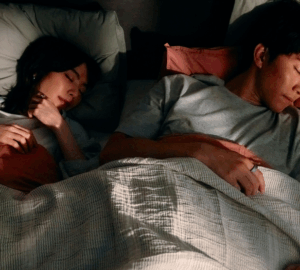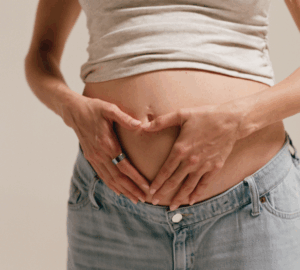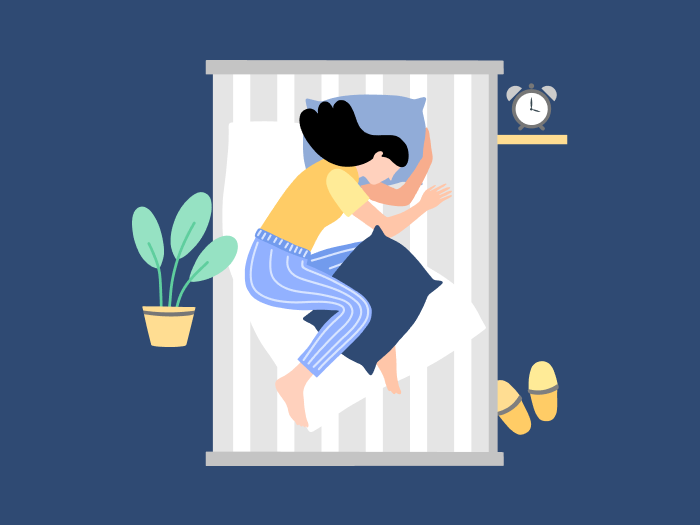- Endometriosis, a condition characterized by abnormal endometrial-like tissue growth outside the uterus, affects 10% of women – impacting their sleep, amongst other things.
- Sleeping on your side, particularly your left side, is ideal as it alleviates pressure on the uterus, promoting better sleep.
- In addition to using Oura to track your sleep, people with endometriosis can also try lifestyle changes like exercise and meditation to sleep more soundly.
Endometriosis, a chronic and painful condition characterized by the abnormal growth of endometrial-like tissue outside the uterus, can affect your quality of life in a number of ways — including your sleep.
According to research, insomnia and fatigue are twice as common among endometriosis patients, who represent roughly 10% of all people who menstruate. To make matters worse, not getting enough quality sleep can aggravate your endometriosis symptoms, creating a vicious cycle of tiredness and pain.
Using Oura, people with endometriosis can better understand their body, and potentially better manage their symptoms and energy levels. For example, using Oura’s Cycle Insights feature, members get to know their cycle, and when symptoms might be about to worsen.
If you have endometriosis, you may wonder what you can do to improve your sleep quality, and maybe even whether there’s an ideal sleeping position to minimize discomfort. To answer these questions, let’s look at some of the most common endometriosis symptoms, plus the best sleeping positions for endometriosis and how to optimize them for maximum comfort.
RELATED: 8 Popular Sleeping Positions: Find Out What They Mean for Your Health
Endometriosis Symptoms
Endometriosis symptoms vary from person to person. While some people will experience severe pain and heavy menstrual bleeding, others have mild or no symptoms at all. The intensity and nature of symptoms can also change over time. Typical symptoms include:
- Pelvic pain: Pelvic pain is the hallmark symptom of endometriosis. The intensity of the pain varies and can occur before, during, or after menstruation, as well as during or after sex and when urinating or defecating. Endometriosis-associated pain is frequently described as a cramping or stabbing sensation, and it may radiate to the lower back or legs.
- Painful menstruation (dysmenorrhea): Endometriosis patients often experience severe menstrual cramps that are more intense than normal menstrual discomfort. The pain may begin a few days before menstruation and last throughout the menstrual cycle.
- Heavy or irregular menstrual bleeding: Endometriosis can cause heavy or prolonged menstrual bleeding. Some people may also experience irregular menstrual cycles or spotting between periods.
- Gastrointestinal symptoms: Endometrial tissue outside the uterus can affect the bowel, causing gastrointestinal symptoms such as bloating, diarrhea, constipation, nausea, or rectal pain. These symptoms may worsen during menstruation.
- Fatigue: The chronic pain and inflammation associated with endometriosis can contribute to fatigue and a general feeling of tiredness.
- Infertility: Endometriosis can affect fertility by causing the formation of adhesions or scar tissue that may block the fallopian tubes or interfere with the release of eggs.
It’s important to note that the severity of symptoms does not always correlate with the extent or stage of the disease. You should consult with a healthcare professional for accurate diagnosis and management of endometriosis.
What’s the Best Sleeping Position for Endometriosis?
Most of the endometriosis symptoms keep sufferers up at night. Oura members can use the Tags feature to track symptoms such as cramps and PMS to see how they affect your sleep and take steps to manage your pain.
Additionally, certain sleeping positions might be better than others for those with endometriosis. Here are some possibilities, and how to sleep even more comfortably.
READ MORE: Can PMS Cause Insomnia and Affect Your Sleep Quality?
Sleeping On Your Side
If you have endometriosis, one of the best ways to sleep is on your side. Sleeping on your left side, in particular, may reduce pressure on your uterus and other organs, which can help alleviate pain and discomfort.
Additionally, sleeping in the recovery position — i.e., lying on your side with your bottom leg straight and your top leg bent toward your belly — can provide the same abdominal release, as well as increase your breathing capacity. This allows you to take in more oxygen which may, in turn, improve your quality of sleep. If you’re an Oura member, you can use the SpO2 feature to measure your blood oxygen levels. If these are consistently below 95%, consider seeing a healthcare provider to determine if these sleep disturbances are caused by a medical condition such as endometriosis.
RELATED: What You Need to Know About the Yearner Sleeping Position
To optimize this position: Consider placing a pillow between your knees to further reduce pressure and provide additional support. Make sure your head and neck are supported with a pillow to prevent neck pain.
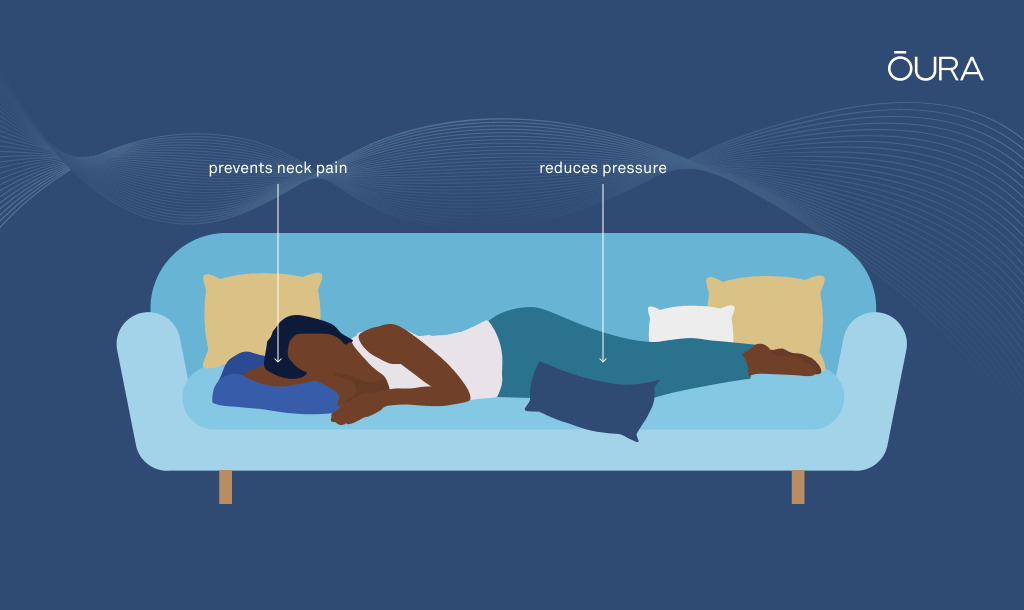
Sleeping in the Fetal Position
The fetal position is a variation of the side-sleeping position. Although lying on your side can help reduce pressure on your abdomen and alleviate lower back pain, pulling your knees up to your chest may not be ideal if you tend to feel bloated or have cramps when experiencing endometriosis symptoms.
When bloating is an issue, try relaxing your legs a little and find a comfortable place within this position that works for you.
To optimize this position: Consider using a body pillow or a pillow between your knees to help position yourself comfortably.
READ MORE: Curling Up In Bed: The Impact of the Fetal Position on Overall Sleep Quality
Sleeping On Your Back
If you prefer sleeping on your back, this is also a great position, as it places very little pressure on your uterus and abdomen, helping to relieve stomach cramps. The supine position is also beneficial for alleviating spine, hip, and knee pain.
To optimize this position: Consider using a pillow under your knees to keep your spine in a neutral position. A pillow will also help relax your abdominal muscles so that you can, hopefully, get some rest.
READ MORE: Is Lying Flat on Your Back the Best Sleeping Position for You?
What Sleeping Position Should I Avoid if I Have Endometriosis?
While sleeping positions are not directly linked to the development or progression of endometriosis, certain positions can exacerbate symptoms and make your overall sleep much less comfortable. For instance, sleeping on your stomach can cause neck and spine problems and reduce your sleep quality.
RELATED: Why Do I Sleep With One Knee Bent Up? The Half-Stomach Position
If you have to sleep on your stomach, you will need to ensure your neck and spine are aligned. To achieve this, consider taking the following measures:
- Place a pillow under your hips to alleviate pressure on your spine.
- Sleep without a pillow for your head, or if you need one, use a thin pillow that does not cause your head to tilt.
Other Ways to Optimize Your Sleep with Endometriosis
Not everyone with endometriosis will experience the same symptoms, so it’s important to remember that what works for one person is not guaranteed to work for another. Here are some more tips that may help you get the rest you deserve.
Exercise Regularly
Research suggests that exercising regularly can ease the symptoms of endometriosis by increasing your body’s anti-inflammatory and antioxidant markers.
Regular exercise can also help relieve menstruation pain by releasing endorphins — your body’s natural painkillers — and increasing blood flow, which reduces muscle tension and cramping.
Oura members can check their Readiness Score in the Oura App to determine how hard to push themselves on any given day. Your Activity Score is also great tool to discover your ideal activity-to-rest balance and adjust your training.
READ MORE: How to Align Your Training With Your Menstrual Cycle
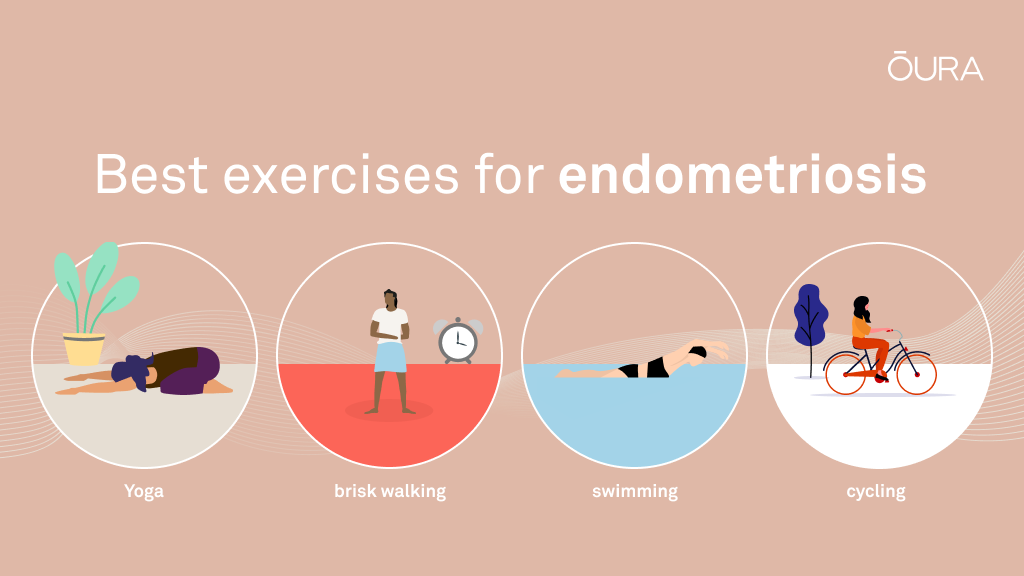
Try Something Different
Sometimes, the position that worked for you one night may not work the next. Experiment with different positions to find the one that addresses your needs each night.
RELATED: Got a Theory? Test It Out
Choose a Good Mattress
A good quality mattress provides support, reduces pain and discomfort, and makes it easier to fall asleep. Therefore, it’s crucial to find one that is comfortable and supportive.
Endometriosis pain may worsen with movement and disturbances during sleep. A good mattress with motion isolation properties can absorb movement and prevent tossing and turning.
The Oura Nighttime Movement feature can show you when you’ve been tossing and turning so you can track how endometriosis symptoms affect your restfulness.
READ MORE: Restless Sleep? How to Reduce Tossing and Turning at Night
Create a Relaxing Sleep Environment
Here are a few ways you can tweak your sleep routine and environment to improve sleep quality:
- Consider taking hot baths before bed. Studies show that a warm bath before bed can lower your body temperature, promoting a feeling of relaxation.
- Listening to guided meditations and drinking chamomile tea can help you relax before bed. In fact, research suggests that chrysin, a compound found in chamomile, suppresses the growth of endometrial cells.
- Incorporating relaxation techniques before bed, such as deep breathing exercises or gentle stretching, can enhance sleep quality and improve mental health.
- Keep your bedroom cool and dark: When your room is cool and dark, you’re more likely to experience deeper, uninterrupted sleep.
READ MORE: 5 Ways to Upgrade Your Sleep Hygiene
Consult Your Healthcare Provider
You may want to consult your healthcare provider for medical advice specific to your situation and sleeping needs. For instance, they may prescribe pain relief medication to help ease endometriosis symptoms when getting ready for bed.
RELATED: How to Use Your Oura Temperature Trends to Track Your Cycle








